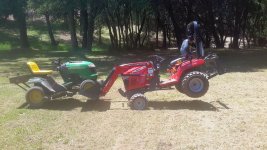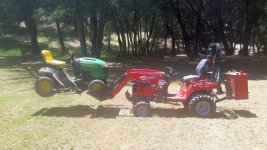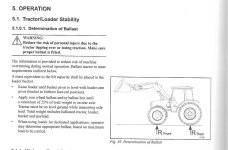k0ua
Epic Contributor
First, I really appreciate all the advice. Thank you all. I guess the question now is how much ballast to have. I have researched this without clear answers but what I learned is that some is better than having none, the owners manuals no longer give that info for many manufacturers of tractors, and some people say to use a weight equal to your maximum front loader capacity.
I guess I could get heavier weights for the 3PH bracket, but lifting these weights is getting hard. Isn't the tractor supposed to keep me from manual work? The forks on my new pallet fork practically killed me. Before I ordered it, I read the reviews and people said the forks are removable, but "kind of heavy". REALLY??? 85 pounds each is more than I care to move around manually these days.
My slopes are probably gradual by most standards. My yard is poorly landscaped and there are lots of dips and rises, that all add a little "thrill" to the tractor ride. Maybe 40 degrees for about 30 feet is as severe as it gets. I did learn the 4WD rule for going down hills the hard way. Luckily I stayed pointed in the right direction, and upright. Just a little older (and maybe wiser).
@oosik: There must be some good fishing in those waters?
@Thomas: Yep. Lebanon. Actually I'm in Etna, but nobody has ever heard of that unless they are local. It's been a tricky adjustment as I always lived near the ocean. Been here 16 years and still really miss the ocean.
you don't need to be lifting any weights to put on the 3pt. Just buy or build a ballast box or ballast barrel and hook it up like any other 3pt implement. You can use a 55 gallon or smaller in your case barrel. You can use the top unused space for storage of other things. I use the top of mine for storage of log-chains. Shoot for about 500-600 lbs for you tractor. You can build your ballast box for certainly less than $100. Start with buying a drawbar at tractor supply and integrate that into your plan, filling the box with concrete or junk iron if you want than concrete over the top. Include some 2 inch PVC tubes upright to hold handle tools, Many will include a 2 inch square receiver hitch on the back integrated and tied into your drawbar inside your concrete mix. The end result is you have a nice rear weight, with the utility of storage on top and handle tool storage and a hitch receiver if you need to install a ball. Put some hooks on the outside so you can hang a couple of 5 gallon buckets on the outside. If you cut a lot of wood, you might want to incorporate a plastic scabbard for a chainsaw too. Use your imagination and/or do a search for ballast boxes and you will find hundreds of them with pictures on this site. Think it thru, look at what others have done, make a plan, and stop lifting and taking off and on weights.



